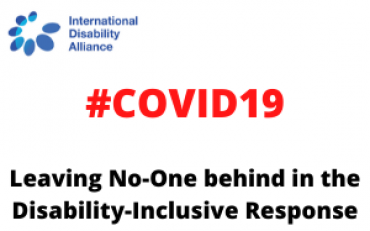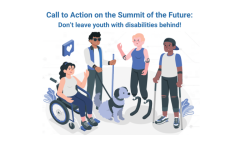This is one story as part of the Voices of People with Disabilities during COVID19 Outbreak series
Names may have been changed to protect the individuals mentioned in the story.
This article is a compilation of the personal experiences of four persons with disabilities in different countries in the Arab region. Interviewees mainly share the barriers faced in accessing information, medical assistance and public transport during the outbreak. The importance of an inclusive COVID-19 response and meaningful involvement of persons with disabilities in the battle against the virus is highlighted.
The experience of woman with a physical disability in Jordan
Sarah is a 30 year old woman and wheelchair user from Amman, Jordan. Sarah is an advocate who used social media to raise awareness of people with disabilities about COVID-19 and to provide up to date information through videos. “I felt it was my responsibility to do some awareness raising videos about the virus and highlight the importance of language and avoid using derogatory terms related to persons with disabilities”, she says. Sarah has also contributed to a successful advocacy campaign that demanded sign language interpretation during official conferences and the King’s speeches.
However, she can no longer continue carrying out advocacy activities due to mental health issues. “At the beginning of the lockdown I was doing fine but now my mental health is being impacted. I need the support of family and friends to see the bright side of this situation”, she says. As a person with a physical disability, Sarah explains that she hasn’t experienced barriers in accessing information as the Jordan Higher Council for the Rights of Persons With Disabilities (HCD) have published simple interactive videos explaining what COVID-19 is and how to prevent contagion, amongst others. However, she wonders if her wheelchair can be a possible source of infection and worries about it. “I don’t think information is accessible for persons with intellectual disabilities. More efforts are required for information to be accessible to everyone”, she says. Sarah has struggled to access her monthly medical and physiotherapy treatment, as she needs a permit to leave the house and visit her doctor, which she hasn’t been able to obtain.
The experience of a deaf woman in Saudi Arabia
Aliya is a deaf woman living in Riyadh, Saudi Arabia’s capital. Her life has drastically changed as she is forced to stay home due to lockdown. “I can't see my sisters, relatives and my friends. I am no longer able to go to work. Instead I work from home”, she says. Aliya works for a disability non-profit organization and has been part of discussions with international deaf organisations on the impact of COVID-19 for the deaf community in the Arab region.
She can access official information on COVID-19 in written form, mainly through newspapers, Twitter, WhatsApp and official government websites. “I would like the Saudi TV to provide live and Closed Captions in news, press conferences and other programs broadcasted on TV. Also the screen that shows the sign interpreter is too small, plus not all of the interpreters are qualified and skilled in Saudi Sign Language” says Aliya.
The population in Saudi Arabia can only have access to medical treatment if it is a life threatening situation. Most clinics are closed, and people are advised not to visit hospitals, to avoid contagion. However, if Aliya were to need to medical assistance, she would not have access to a sign language interpreter. “We don’t have professional Saudi sign language interpreters. Those who work in interpretation field are not trained at the university level”, she says.
In Saudi Arabia, those who hold a BA, MA, and PHD are not trained professionally as interprets, therefore, their skills in Saudi Sign Language vary. They often work as interpreters on the side and their major isn’t in Saudi Sign Language Interpretation, they are mostly majored in Deaf Education. Most of them are Children of Deaf Adults (CODAs), teachers for the Deaf, or have a Deaf sibling in their family.
Aliya explains that most of the deaf population have low literacy levels, meaning they can’t read well and during COVID-19, they rely completely on the signed information (videos and infographics). “As I am fluent in both Arabic and English, this enables me to read the news in either language”. Moreover, Aliya’s father and brother have been helping and supporting her during COVID-19 as they live in the same house but she is aware that not many deaf individuals can count on family members. “Not all the families of the deaf are supportive and helpful like mine” she says.
The experience of a woman with Down Syndrome in Egypt
Rashida is a woman in her mid-30s living in Cairo, Egypt. She has Down Syndrome and is a teacher for students with disabilities. “I can’t go to the mosque and I’m sitting at home a lot”, she explains. Her life has been limited to staying indoors. She lives with her mother but not seeing her other family members nor friends has made her feel sad and lonely. Also, public transport is scarce, which means she cannot travel independently anymore and can only travel with her mother by car, which is also more expensive. Not being able to go to work has really affected her so she has decided to get involved in providing general guidelines on COVID-19 for parents with children with disabilities online, and help coordinate a group that provides up-to-date information. However, she explains that information is not always accessible or understandable and never in easy language. “I’m worried that COVID-19 will last longer. I want my life back”, she says.
The experience of a blind man in Tunisia
Mehdi is a man in his mid-40s from Tunisia. He is partially-sighted and chairperson of a local DPO. He is no longer working and his salary has been cancelled. “I am struggling to secure essential products and food”, he says. This has caused him great worry and anxiety particularly because he has to support his wife and two children. Mehdi obtains official information through TV news and Facebook. Written information and videos to create awareness on COVID-19 have been released, and most of them are accessible. However, no special protocol has been put in place to deal with issues concerning protection, medication and food shortages. There has been some specific recommendations for persons with disabilities but they are not detailed enough and difficult to put in practice. “The only real action the government has taken is to make persons with disabilities stay at home. This is not good enough. Governments should learn a lesson from COVID-19 and include persons with disabilities in their response”, he says.

